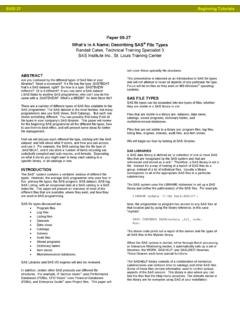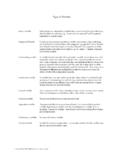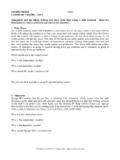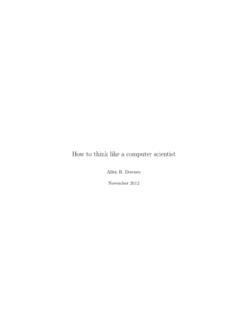Transcription of 265-2008: Headings and Super-Headings: Using …
1 Paper 265-2008 Column Headings and super - Headings : Using ACROSS Variables in PROC REPORT Jillian Campbell, Howard M. Proskin and Associates Inc., Rochester, NY ABSTRACT Programmers are commonly requested to produce tables that include variable values as column Headings . The use of an ACROSS variable in PROC REPORT can easily accommodate this request. In some cases the tables must include multiple variables as column Headings . In these cases, two ACROSS variables can be used in PROC REPORT. This technique allows a SAS programmer to include variables as column Headings and super - Headings with little to no additional programming. INTRODUCTION When a programmer is given a table template and the task of creating a matching data table Using SAS, there are many ways the programmer can reach that end goal. The use of across variables can increase program efficiency and decrease program complexity.
2 In this paper I will work through an example of how to generate a table that includes a heading and a super -heading (Table 1). For simplicity I have divided the programming into two steps: (1) formatting the input dataset, and (2) Using the proper Proc Report commands. Table 1 Children Clothes & Shoes Sports Statistic Children Sports Clothes Shoes Swim Sports Team Sports Winter Sports MAX 3161 7332 7850 3704 3674 3462 MEAN 716 1159 3858 2256 1036 1453 MIN 10 25 1759 1117 109 485N 176 240 48 16 64 32 STD 671 1636 1674 1021 919 847 Source FORMATTING THE DATASET To make use of an across variable , every record in the input dataset must include a variable that contains the value of the across variable . For example, Table 1 involves the use of two separate across variables, product line and product category, thus the input dataset must include a variable for product line and a variable for product category (see Figure 1).
3 In the current example the input dataset (Figure 1) was created with the following program: **SUMMARIZE THE DATA FOR THE PROC REPORT PROCEDURE; PROC SUMMARY DATA= ; **TOO MANY PRODUCT CATEGORIES TO FIT ON ONE PAGE, SO SOME ARE ELIMIATED; WHERE PRODUCT_CATEGORY NOT IN('ASSORTED SPORTS ARTICLES', 'GOLF','INDOOR SPORTS','RACKET SPORTS','RUNNING - JOGGING','OUTDOORS'); **PRODUCT LINE AND PRODUCT CATEGORY WILL BE MY ACCROSS VARIABLES; CLASS PRODUCT_LINE PRODUCT_CATEGORY; TYPES PRODUCT_LINE*PRODUCT_CATEGORY; VAR QUANTITY PROFIT; OUTPUT OUT=FIGURE1(DROP=_TYPE_ _FREQ_); RUN; - 1 - Reporting and Information VisualizationSASG lobalForum2008 Figure 1 Notice that in the input dataset each record contains a value for product line and for product category represents. Also, notice that each record corresponds with one data cell in Table 1. The input dataset is now complete. The next step is Using PROC REPORT to produce the data table.
4 Using PROC REPORT BACKGROUND PROC REPORT includes seven possible statements: BREAK, BY, COLUMN, DEFINE, FREQ, RBREAK, and WEIGHT. In this paper, only the COLUMN statement and DEFINE statement are used. The COLUMN statement in PROC REPORT is used to list the variables that will be presented in the report. The COLUMN statement is used by PROC REPORT to determine the order and arrangement that the variables will be displayed. The DEFINE statement in PROC REPORT is used to define what type of variable for each variable listed in the COLUMN statement. The PROC REPORT procedure includes five different types of variables that can be defined: ACROSS, ANALYSIS, COMPUTED, DISPLAY, GROUP, and ORDER. All of these, with the exception of ACROSS variables, will be presented vertically. (Table 1 utilizes GROUP, ANALYSIS, and ACROSS variables.) GROUP variables are used to display multiple records from the input dataset in a single row of the report.
5 In the example presented in Table 1, the first column of the report includes a GROUP variable , _STAT_ (Statistic). (Notice that each record in Figure 1 that contains _STAT_= MAX is displayed in the first row of the report.) ANALYSIS variables can be used to present numerical variables. All numeric variables are ANALYSIS by default. The variable QUANTITY (Number of Items) is as an ANALYSIS variable . ACROSS variables are used to define columns in PROC REPORT, each value of an ACROSS variable is presented as a column in the report. In this example, there are two ACROSS variables: PRODUCT_LINE ( Product Line ) and PRODUCT_CATEGORY ( Product Category ). - 2 - Reporting and Information VisualizationSASG lobalForum2008 THE COLUMN STATEMENT The COLUMN statement must carefully layout the order in which the columns and across variables will occur. The first variable mentioned in the COLUMN statement will be the variable that occurs in the far left of the report.
6 The syntax for where to list ACROSS variables in the COLUMN statement is a little more difficult to understand. The variable that will be used as the top most heading must appear before the second heading, which must appear before the third heading, and so on. All ACROSS variables in the COLUMN statement must be separated by a comma. After all ACROSS variables have been listed (separated by commas), the name of the variable that includes the data table cell values is listed. The COLUMN statement for Table 1 is: COLUMN ('Statistic' _STAT_) PRODUCT_LINE,PRODUCT_CATEGORY,QUANTITY; The above COLUMN statement indicates that _STAT_ will be presented in a column to the far left (with the word Statistic as a column label), PRODUCT_LINE will define the column super - Headings , PRODUCT_CATEGORY will define column Headings , and QUANTITY contains the data to be presented in the report.
7 THE DEFINE STATEMENTS Once the COLUMN statement has been defined, each variable should be defined Using a DEFINE statement. The PROC REPORT code used to produce Table 1 is given below: PROC REPORT DATA=FIGURE1 NOWINDOWS; COLUMN ('STATISTIC' _STAT_) PRODUCT_LINE,PRODUCT_CATEGORY,QUANTITY; DEFINE _STAT_ / '' GROUP; **THE NO ZERO COMMAND IS USED SINCE ALL PRODUCT CATEGORIES WILL NOT BE REPRESENTED FOR EACH PRODUCT LINE IN THE TABLE; DEFINE PRODUCT_LINE/ '' ACROSS NOZERO ORDER=INTERNAL; DEFINE PRODUCT_CATEGORY / '' ACROSS ORDER=INTERNAL; INE QUANTITY / '' ; DEFRUN; In the completed PROC REPORT there are two additional commands that are necessary that were not previously discussed. The first is that if two or more ACROSS variables are used in the DEFINE statement the NOZERO command is often necessary. The second is that in order for the column label for GROUP variables ( , _STAT_) to align horizontally with the ACROSS variables the column label must be presented in the COLUMN statement as opposed to in the DEFINE STATEMENT.
8 The command NOZERO indicates that empty columns will not be presented. Without this command the same column Headings will be presented for all values of ACROSS variables (Table 2 is produced when the NOZERO command is excluded from the PROC REPORT code). Table 2 Children Statistic Children Sports Clothes Shoes Swim Sports Team Sports Winter Sports MAX 3161 .. MEAN 716 .. MIN 10 .. N 176 .. STD 671 .. Clothes & Shoes Children Sports Clothes Shoes Swim Sports Team Sports Winter Sports . 7332 7850 .. 1159 3858 .. 25 1759 .. 240 48 .. 1636 1674 .. Sports Children Sports Clothes Shoes Swim Sports Team Sports Winter Sports .. 3704 3674 3462 .. 2256 1036 1453 .. 1117 109 485 .. 16 64 32 .. 1021 919 847 - 3 - Reporting and Information VisualizationSASG lobalForum2008 If the column labels for GROUP variables are presented in the DEFINE statement, as opposed to in the COLUMN statement, the data table will include an extra row for the column label (see Table 3).
9 Table 3 Children Clothes & Shoes Sports Children Sports Clothes Shoes Swim Sports Team Sports Winter Sports Statistic MAX 3161 7332 7850 3704 3674 3462 MEAN 716 1159 3858 2256 1036 1453 MIN 10 25 1759 1117 109 485 N 176 240 48 16 64 32 STD 671 1636 1674 1021 919 847 DISCUSSION ACROSS variables can be easily used to produce tables with multiple column Headings ; however, there are a few issues that are worthy of mention. The CELLWIDTH style option in the DEFINE statement is not easily implemented. If the CELLWIDTH option is specified in the DEFINE statement for the ANALYSIS variable then all ACROSS variable columns will be of identical size. For the display of character variables, as opposed to numeric ANALYSIS variables, I have had the best results when these variables are specified as GROUP variables. I usually use character variables as opposed to numeric when creating reports, since all values of an ANALYSIS variable will have the same format in the data table.
10 (Note that a character variable could contain the number for the Mean record and 12 for the N record.) Parenthesis can be used to specify the display of multiple values beneath a column heading. The code listed below will product a report that includes a column for QUANTITY and a column for PROFIT beneath a single column heading (see Table 4): PROC REPORT DATA=FIGURE1 NOWINDOWS; COLUMN ('STATISTIC' _STAT_) PRODUCT_LINE,PRODUCT_CATEGORY,(QUANTITY PROFIT); DEFINE _STAT_ / '' GROUP; **THE NO ZERO COMMAND IS USED SINCE ALL PRODUCT CATEGORIES WILL NOT BE REPRESENTED FOR EACH PRODUCT LINE IN THE TABLE; DEFINE PRODUCT_LINE/ '' ACROSS NOZERO ORDER=INTERNAL; DEFINE PRODUCT_CATEGORY / '' ACROSS ORDER=INTERNAL; DEFINE QUANTITY / 'Q' ; DEFINE PROFIT / 'P' FORMAT=6.; RUN; Table 4 Children Clothes & Shoes Sports Statistic Children Sports Clothes Shoes Swim Sports Team Sports Winter Sports Q P Q P Q P Q P Q P Q P MAX 3161 58258 7332 209708 7850 383969 3704 74304 3674 64960 3462 254707 MEAN 716 13734 1159 38368 3858 185199 2256 45492 1036 15738 1453 122776 MIN 10 210 25 1666 1759 90266 1117 22945 109 1350 485 52941 N 176 176 240 240 48 48 16 16 64 64 32 32 STD 671 13890 1636 45877 1674 84532 1021 19899 919 17294 847 62221 - 4 - Reporting and Information VisualizationSASG lobalForum2008 CONCLUSION Defining ACROSS variables in PROC REPORT is an extremely useful tool for producing stylized data tables.















